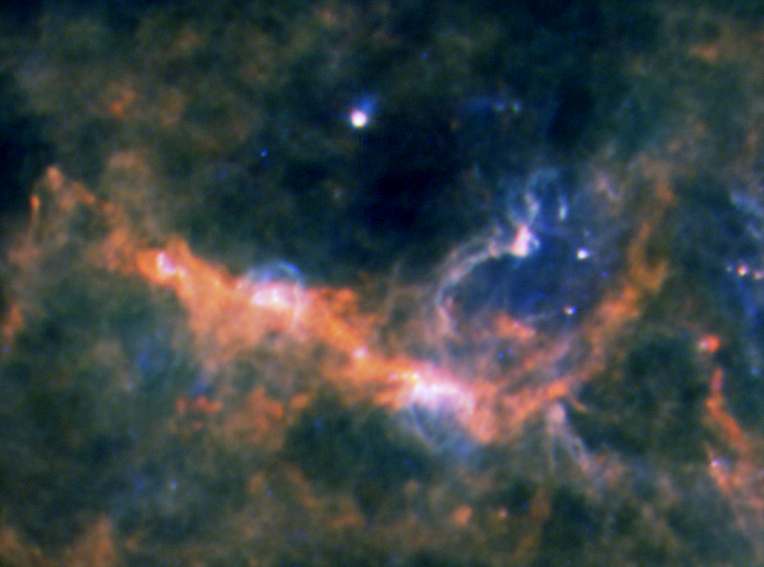Stars are born in molecular clouds, and molecular clouds are formed from condensed atomic gaseous clouds that are predominately made of neutral hydrogen. Astronomers have recently discovered that the formation of massive stars proceed almost simultaneously as molecular clouds form. The apparently surprising findings support a fast and dynamical scenario of massive star formation, in contrast to traditional picture.
A research team led by Ke Wang at the Kavli Institute for Astronomy and Astrophysics at Peking University used the Five-hundred-meter Aperture Spherical radio Telescope (FAST) to observe two typical filamentary giant molecular clouds (GMCs) in the center of the Milky Way's spiral arms (also known as the "skeleton" structure), and discovered cold neutral hydrogen commonly associated with molecular CO emission [1]. From the complex HI spectral-line cubes observed by FAST, the astronomers extracted HI narrow self-absorption (HINSA) signals [3,4] to single out cold neutral hydrogen condensed from ambient warm and hot medium. HINSA marks cold atomic gas, and its association with molecular CO emission shows ongoing transition from atomic to molecular gas, i.e., the formation of GMCs. Subsequently, GMCs are the birth place of massive stars which drive the evolution of galaxies. In these two particular GMCs, massive star formation activity is observed in a number of dense cores. By comparing FAST observed HINSA with a chemical model, the research team derived the chemical ages of the GMCs. Surprisingly, they found that the time scales for molecular cloud formation are comparable to the time scales of star formation therein. In other words, FAST has witnessed nearly simultaneous cloud formation and star formation. The findings strongly support a fast star formation scenario within a dynamical time scale, and challenge traditional theoretical model of slow star formation proceeding in quasi equilibrium.

Fig 1. Herschel far infrared composite image of the filamentary giant molecular cloud G47, where cold dust glows in red/orange, and warm dust glows in blue. G47 spans over 250 light years and contains gas and dust weighting more than 20 thousand solar mass. Image from ESA/Herschel/Ke Wang et al. 2015 [2].
The research paper has been published in the Astrophysical Journal Letters [1]. The lead author is Shenglan Sun, PhD student in the Department of Astronomy, School of Physics at Peking University, and the corresponding author is Ke Wang of KIAA-PKU. The other authors are Xunchuan Liu of Shanghai Astronomical Observatory (former PKU astronomy graduate, currently visiting Leiden University in the Netherlands), and Fengwei Xu, PhD student in Ke Wang’s group (currently visiting University of Cologne in Germany). The paper is the result of an undergraduate research project conducted by Shenglan Sun and supervised by Ke Wang.
This study benefited from FAST’s high sensitivity, high spectral resolution and fast scanning imaging capabilities, which led to the discovery of HINSA associated with CO in GMCs at far distances typical for massive star formation regions, paving the way of using HINSA to study cloud formation and the initial conditions for massive star formation in the FAST era.

Fig 2. Column density (left) and spectra (right) of G47. Circles in the left panel mark the positions for HI spectra extraction of HI cubes. The upper right panel plots the FAST observed HI spectrum from position G47-ON1 in black, and the reconstructed HI spectrum free of absorption in blue. The lower right panel plots the HINSA spectrum in red, which is derived from the HI spectrum guided by 12CO and 13CO. Figure from [1].
The study demonstrates that FAST has unique advantages in the observational study of molecular cloud formation. Estimates suggest that the Milky Way's "skeleton" structure contains at least thousands of similar filamentary GMCs, and Ke Wang's team has conducted a detailed census of them in a series of works in recent years [5]. Next, the team is using FAST to carry out systematic observational research on the formation of molecular clouds, aiming to reveal the formation mechanism of the Milky Way's skeleton structure, thereby providing key observational constraints on the initial conditions for the formation of massive stars.
References
[1] Sun et al 2024, ApJL, 973, L27, https://iopscience.iop.org/article/10.3847/2041-8213/ad77ce
[2] Wang et al. 2015, MNRAS, 450, 4043, https://academic.oup.com/mnras/article/450/4/4043/989841
[3] Li et al. 2003, ApJ, 585, 823, https://iopscience.iop.org/article/10.1086/346227
[4] Liu et al. 2022, A&A, 658A, 140, https://www.aanda.org/articles/aa/abs/2022/02/aa41477-21
[5] Wang et al. 2024, A&A, 686L, 11, https://www.aanda.org/articles/aa/abs/2024/06/aa50296-24